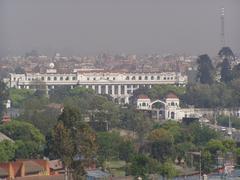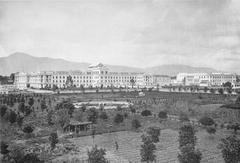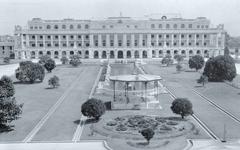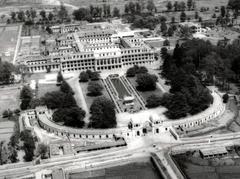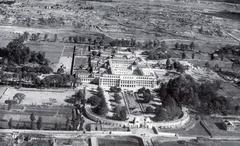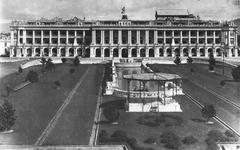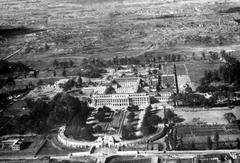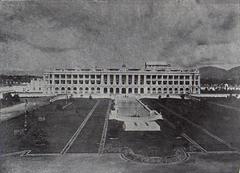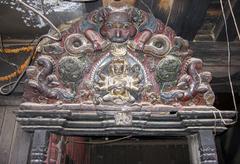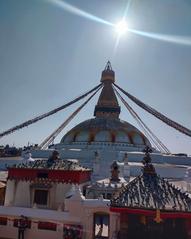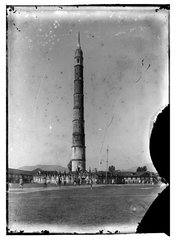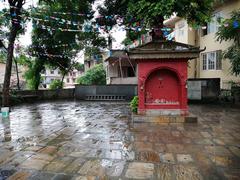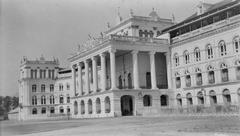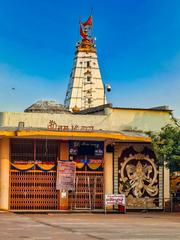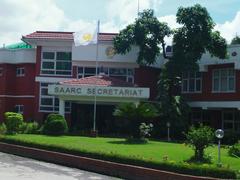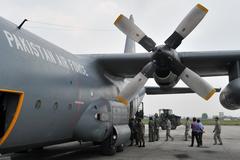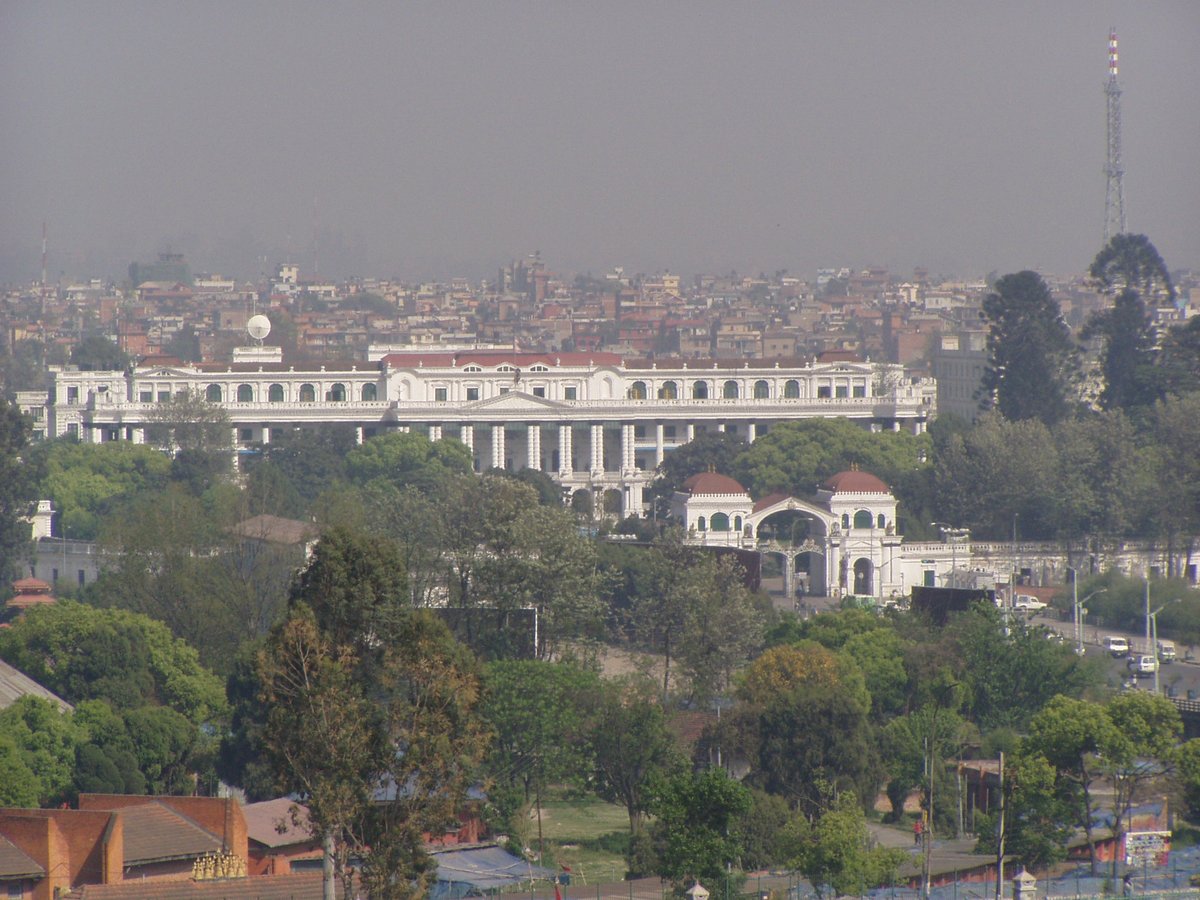
Singha Durbar Visiting Hours, Tickets, and Historical Significance in Kathmandu, Nepal
Date: 14/06/2025
Introduction
Singha Durbar, the “Lion Palace,” is a monumental landmark at the heart of Kathmandu, Nepal, representing more than a century of political transformation and architectural grandeur. Constructed during the early 1900s under the patronage of Prime Minister Chandra Shumsher Jung Bahadur Rana, this neoclassical marvel not only symbolizes the opulence of the Rana dynasty but also serves as the seat of Nepal’s federal government today (Alluring World; Nepal in Data). This guide provides a deep dive into Singha Durbar’s historical background, visitor information, accessibility, and practical tips—everything you need to plan an enriching visit or to appreciate its cultural significance from afar.
Table of Contents
- Introduction
- Historical Background
- Visiting Singha Durbar
- Frequently Asked Questions
- Conclusion
- References
Historical Background
Origins and Construction
Singha Durbar was commissioned by Chandra Shumsher Jung Bahadur Rana and constructed between 1903 and 1908. Initially a private residence, it quickly became the largest palace in South Asia, featuring over 1,700 rooms, seven courtyards, and a sprawling 50-hectare campus (Spaces Nepal Blog). The palace’s construction cost an estimated 5 million Nepali rupees—a testament to the Ranas’ immense wealth and power (ImNepal).
Architectural Features
Designed by engineers Kumar Narsingh Rana and Kishor Narsingh Rana, Singha Durbar’s architecture is an eclectic fusion of neoclassical, Corinthian, Baroque, and Palladian elements, blended with Nepali motifs. Its grand façade, marble floors, painted ceilings, crystal chandeliers, and the iconic lion statue atop the building epitomize European opulence and local symbolism (Alluring World; Nepal in Data; ibnbattutatravel.com).
Political and Modern Significance
Originally the seat of the Rana prime ministers, Singha Durbar became government property after the fall of the Rana regime in 1951. Today, it houses the Federal Parliament, multiple ministries, and national broadcasters such as Radio Nepal and Nepal Television, serving as the administrative and political hub of Nepal (Wikipedia; Setopati).
Restoration and Preservation
Singha Durbar faced significant damage from a fire in 1973 and the 2015 earthquake. Restoration projects, with investments exceeding Rs 10 billion, continue to balance heritage preservation with the requirements of a modern government complex (MyRepublica). These efforts include the restoration of architectural features, addition of gardens, ponds, and even a helipad for official use.
Visiting Singha Durbar
Visiting Hours
- Government Working Days: Sunday to Friday, 10:00 AM – 5:00 PM
- Closed: Saturdays and public holidays
- Note: Singha Durbar is a high-security government zone. Regular public access to the interior is generally not permitted; entry is restricted to authorized personnel, diplomats, or those with special permits (Trip.com).
Entry Procedures and Tickets
- E-Gate Pass: All visitors must apply for a free QR-coded online e-gate pass before arrival (Techmandu).
- On-site Entry: Those unable to use the e-pass system may present a valid government-issued ID at the south main gate and be accompanied by security staff.
- Fees: Entry is free for those with official business; there are no regular tourist tickets. Special guided tours, when available, may charge a nominal fee.
Accessibility
- Wheelchair Access: Some exterior areas are accessible, but ongoing restoration and historic structures may limit full access. Contact administration ahead for assistance.
- Facilities: No public restrooms or visitor centers on site; nearby Thamel and Durbar Marg offer amenities.
Travel Tips
- Best Time to Visit: October–December and February–April for pleasant weather.
- Transportation:
- Taxi: Fares from Thamel are NPR 300–500 (negotiate or use a meter).
- Bus: Ratna Park and New Bus Park have routes that stop near Singha Durbar (NPR 20–30).
- Walking: 15–20 minutes from Ratna Park.
- Security: Follow all instructions, avoid restricted zones, and do not photograph security personnel or sensitive installations.
- Dress Code: Modest attire is required due to the site’s official nature.
Nearby Attractions and Photo Spots
- Kathmandu Durbar Square: UNESCO site with palaces and temples.
- Garden of Dreams: Historic garden, ideal for relaxation.
- Ratna Park: City park within walking distance.
- Best Photo Spots: The main gate with lion statues and the grand façade as seen from Singha Durbar Marg. Early morning and late afternoon offer optimal lighting.
Frequently Asked Questions (FAQ)
Q1: Can I tour the interior of Singha Durbar?
A: General public entry is not permitted. Access requires special permission or participation in rare public heritage events.
Q2: How do I get an entry pass?
A: Apply for an e-gate pass online (Techmandu). Present ID at the south gate if necessary.
Q3: Is photography allowed?
A: Yes, in exterior and garden areas. Interior photography is restricted.
Q4: Are guided tours available?
A: Occasionally, through official channels or during special events.
Q5: Is Singha Durbar accessible for those with disabilities?
A: Accessibility is limited; contact the administration in advance for assistance.
Conclusion
Singha Durbar remains a powerful emblem of Nepal’s political and cultural evolution—its grand neoclassical façade and storied past offering a compelling narrative for visitors and locals alike. While interior access is restricted, viewing the palace from the surrounding area, especially the iconic lion-flanked entrance, is a must for anyone interested in Kathmandu’s heritage. For the latest information on access, restoration, and cultural events, consult official resources or download the Audiala app.
Combine your visit to Singha Durbar with nearby heritage sites like Kathmandu Durbar Square and the Garden of Dreams to experience the full breadth of Kathmandu’s historic and architectural legacy. Respect security protocols, plan ahead, and immerse yourself in the story of Nepal’s journey from autocracy to democracy.
References
- Alluring World - Singha Durbar Palace
- Nepal in Data - Back in Time: Singha Durbar
- Wikipedia - Singha Durbar
- Setopati - Construction of Parliament Building in Singha Durbar
- MyRepublica - Singha Durbar Restructuring
- NepalsBuzzPage - Tracing the Political Heartbeat of Nepal’s History
- Ibn Battuta Travel - Singha Durbar
- Techmandu - Online Pass to Visit Singha Durbar
- Trip.com - Singha Durbar
For more travel tips, downloadable resources, and heritage guides, visit our website or follow Audiala across social media platforms.
